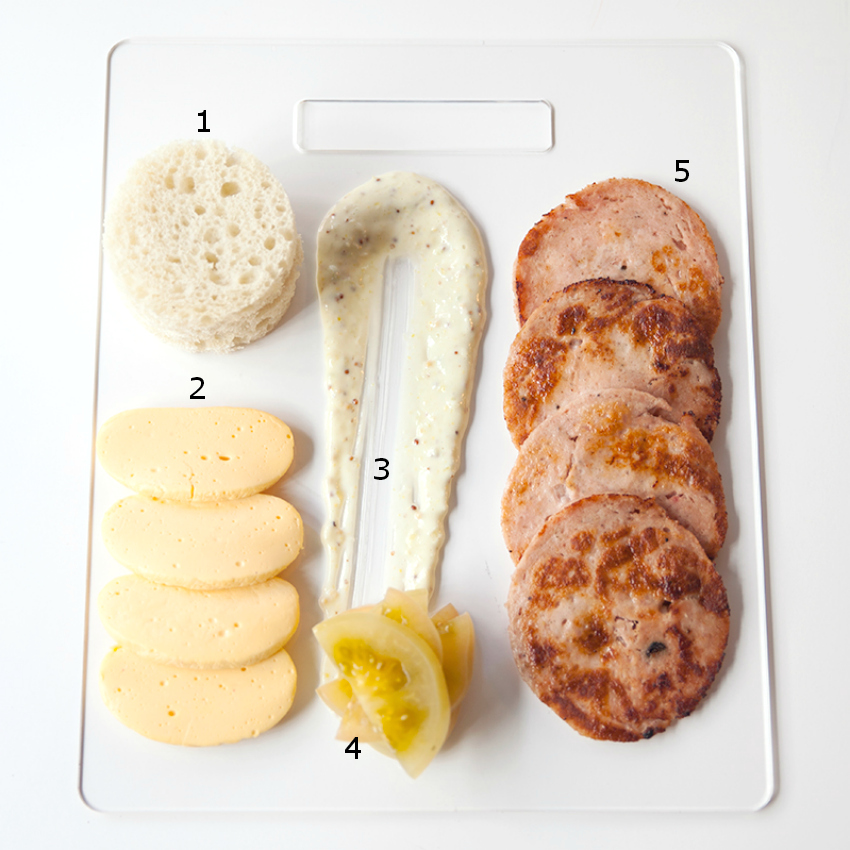Sam Monsour Talks Us Through JM Curley’s ‘The Future of Junk Food’ Menu
At Downtown Crossing bar/hangout JM Curley, chef Sam Monsour has made his name applying a thoughtful high-brow sensibility to approachable, lowbrow-style dishes (pickled deviled eggs, spicy fried pickles, bacon-laced cracker jack). With his most recent seasonal menu, Monsour has taken his ethos to the next level, with a selection of dishes under the heading of “The Future of Junk Food.” To Monsour, though, these dishes—which include his take on Doritos, doughnuts, hot pockets, and more— represent more than just a fun wink. They’re a personal comment on how this country perceives what it means to eat a balanced, responsible meal. “When you say that you either have to only eat farm-to-fork and be an extremist locavore or be someone that only lives on junk and McDonald’s and there’s no room in between, I think that makes better choices feel unattainable—that it’s all or nothing,” Monsour explains. “It doesn’t matter what you’re eating, you can make better choices.”
Enter mind-benders like “Doritos” dusted in powdered beets, and “Hot Pockets” stuffed with farm veggies and local raclette. The focus here by no means on low-cal, “health food,” but rather on food that’s been made with real, local product. “If you look at farm-to-fork dining and get put off by the fact that it’s in a white table cloth setting and costs more money, well, this is proof that you can eat what noone would consider to be nutritious or made with integrity,” Monsour says. Get a detailed look at the limited-run menu (which ranges from $6 to $17 per item) and the thought behind each dish ahead.
1. The foie gras doughnut. For this, Monsour (left) fries a yeasted doughnut in a mix of bacon fat and canola oil, and fills it with a strawberry-rhubarb puree (the strawberries come from Schartner Farm in Rhode Island). Then it gets a heavy dousing of a glaze made of rendered Hudson Valley foie gras, confectioner’s sugar, and water. “It’s got a clean foie flavor as opposed to a seared foie,” Monsour says. “It has a flavor like a torchon.” As a final touch, the doughnut is topped with basil sugar from Fresh Origins.
2. Up next, the beet “Doritos” (which should be called beet-o-ritos, no?). At top left, a 25-pound case of beets that’s been dehydrated and about to be ground. Next, Monsour blends the beet powder with citric acid (for tang), kosher salt, maltodextrin (for texture), and msg (for addictive-ness). Believe it or not, the chips themselves (which come from Everett-based operation Tortilleria La Nina) are yellow before the heavy coating of beet powder is applied. Monsour says he’s working on a rendition of pig-ear cheetos to replace the doritos as the menu evolves, but he’s still working out the details.
3. The Double Down. At first glance, it’s almost eerie how much this resembles a grilled cheese sandwich, but there’s no bread or cheese to be found here. Instead, as a play on the infamous KFC fried chicken sandwich, Monsour crafted a chicken mousseline, which was baked in a loaf pan. Slices of the chicken are then fried for a glorious golden crust, and layered with a spicy Thai red curry mayo. For brightness, the dish is topped off with micro-cumin, pea shoots, and mint, as well as a pipette of a clean, vinegar-and jalapeno-based house hot sauce.
4. The “White Trash Charcuterie Board:” This dish has since been replaced with Monsour’s take on the McRib (more on that later), but this board was inspired by the bologna sandwiches of the chef’s southern childhood. “I actually grew up on Oscar Meyer bologna, Wonderbread, and Hellman’s mayonnaise,” Monsour says. His goal with this? To recreate the “stick to the roof of your mouth” texture of a Wonderbread sandwich. The components, as follows: 1) Nashoba Brook bread. 2) House Velveeta, made from Richardson’s Dairy whole milk that’s blended with Cabot cheddar, gelatin, and tartaric acid (to stabilize the gelatin; combined, the two ingredients provide that Velveeta-like bouncy texture). To add a bit of heat, the mix is infused with habanero and scotch bonnet peppers from Schartner Farm. 3) Spring garlic and grainy mustard remoulade. 4) Pickled green tomatoes. 5) Griddled slices of bologna made in house from a Brambly Farms pig.
While you won’t find this exact preparation on the menu anymore, the Velveeta can now be found on Monsour’s version of a McRib—those sauce-laden meat sponges from McDonald’s that folks can’t help but fetishize. The chef’s version is quite an upgrade, made with a pork farce (also from a Brambly pig) that’s shaped into a rib-esque patty and topped with bbq sauce, slices of the Velveeta, shaved onion, and the pickled green tomatoes.
5. The Hot Pocket. This is the most straightforward of the group of dishes, and also one of the most popular on the menu, Monsour says. A flaky crust is stuffed with raclette from Spring Brook Farm in Vermont, plus an array of spring-dug root vegetables. Come summer, Monsour says he’ll swap out the vegetables for a more seasonal filling. On top? A tiny tempura carrot.
 6. The piece de resistance, Easy Cheese. It took Monsour months of trials to figure out how to inject an Easy Cheese can with his own remade version of the product. But with the help of a basketball pump (seriously) he’s able to inject his own morel-infused American cheese, which guests can squeeze out (here, over cubes of toast with fresh peas and micro radish ruby) onto whatever they please. The Easy Cheese is no longer a written item on the menu (it’s been replaced with a braised rabbit and farm egg-topped personal pan pizza), but those in the know will be able to request a can for the table (once morels go out of season, Monsour plans to do a beer-spiked version of the cheese). Now you know.
6. The piece de resistance, Easy Cheese. It took Monsour months of trials to figure out how to inject an Easy Cheese can with his own remade version of the product. But with the help of a basketball pump (seriously) he’s able to inject his own morel-infused American cheese, which guests can squeeze out (here, over cubes of toast with fresh peas and micro radish ruby) onto whatever they please. The Easy Cheese is no longer a written item on the menu (it’s been replaced with a braised rabbit and farm egg-topped personal pan pizza), but those in the know will be able to request a can for the table (once morels go out of season, Monsour plans to do a beer-spiked version of the cheese). Now you know.








